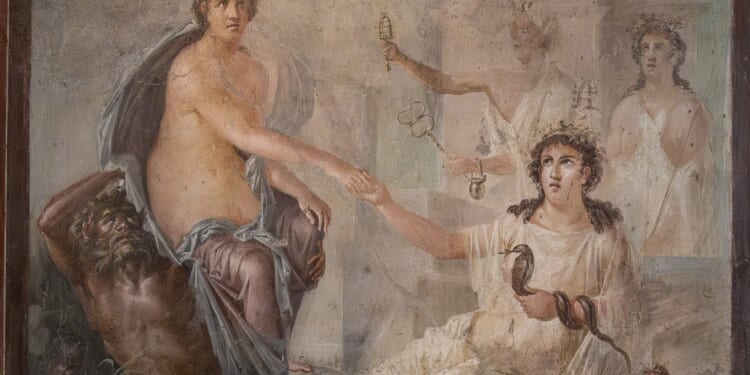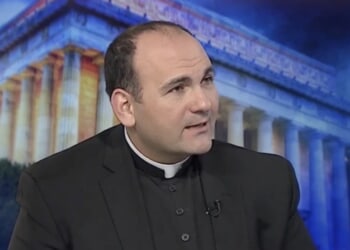The mystery cults of classical Greece and Rome remain appropriately mysterious to historians. In contrast to the mainstream currents of Greco-Roman paganism, where rites were conducted in the open, these secretive practices were observed in sequestered chambers by a chosen few. On being inducted into such a cult, the initiate bore witness to astonishing sights and sounds: these were the eponymous “mysteries,” of which few eyewitness accounts have survived, as the initiate was expected to keep whatever he or she had seen a secret on pain of death. Although mystery cults were already prevalent in archaic Greece (with the famous Eleusinian Mysteries practiced in the outskirts of Athens), some mystery cults, such as the worship of the Egyptian Isis and the Persian Mithras, attained empire-wide popularity in the Roman imperial period.
To Edward Gibbon, the spread of these cultish practices was a symptom of Rome’s degenerate decline. In his landmark work The History of the Decline and Fall of the Roman Empire (1776–89), Gibbon decried the “perpetual stream of strangers and provincials” that flowed into imperial Rome and connected their “abhorrent mysteries” with the rise of Christianity, his great bugaboo. Two centuries after Gibbon published his work, a young student at a seminary in Pennsylvania wrote an essay on the relationship between early Christianity and these secretive cults. The author of the paper, Martin Luther King Jr., notes a common theme between Christianity and the pagan secret groups, namely the emphasis on the resurrection of the dead and the life to come, eventually, and perhaps unsatisfactorily, concluding that they had little direct influence on each other despite their similarities.
In his new book, The Secret Sacred, Damien Stone initiates the reader into the festive, miraculous, and oftentimes downright sinister world of the mysteries. In the introductory chapter, Stone briefly explains the origin of the Greek word mysteria, derived from the Hittite verb meaning “to conceal,” describes the common traits of the mystery cults, and lays out the historical context in which they developed. In each of the ensuing eight chapters, Stone discusses a particular mystery cult or a family of related cults and provides some interesting nuggets of lore surrounding these mysterious rituals.
Stone is an archaeologist by training, and his interest in the material culture is evident from the generous number of photos accompanying his text. These mainly show sculptures associated with the various mysteries, with some frescoes thrown in for good measure. To those acquainted only with the more conventional depictions of the Olympian gods (Zeus with his thunderbolt, Poseidon with his trident), some of these artifacts will seem bizarre and exotic. Indeed, they probably would have seemed no less exotic to the uninitiated Roman citizen. As Stone emphasizes, spectacle, often of a grotesque and gratuitous sort, was a major component of the beliefs and rituals of the cults. Shown in the chapter concerning cults imported from Asia Minor is a rather crudely chiseled relief of Attis, consort of the Great Mother Cybele, in the midst of castrating himself. Fountains of blood, which once would have been brightly painted, gush from his wound. The author goes on to describe the feast day of the cult of Cybele, the Dies Sanguinis (Day of Blood), in which the priests of the cult castrated themselves in a ritual reenactment of this myth, epitomizing the motif of death and rebirth central to many of the mystery cults. The priests of Cybele (called galli, a word literally meaning “rooster”) were considered to be a third sex between male and female and were largely shunned from polite Roman society, although they feature prominently in Catullus 63. Stone’s accounts of these practices are descriptive and detailed but avoid sensationalism.
On a more lighthearted note, Stone devotes the penultimate chapter of the book to the cult of the serpent Glycon, described in Alexander the False Prophet, a treatise of the second-century satirist Lucian of Samosata. According to Lucian, this peculiar deity was the invention of a fraudster named Alexander of Abonoteichos, who placed an infant snake inside a goose egg and “hatched” it in a public place for all to see. He took the snake home, replaced it with a full-grown and apparently quite tame snake of a similar species, and attached a kind of mechanical apparatus to its head. Using a technique familiar to modern ventriloquists, he made it “speak” before an astonished crowd. Lucian describes the audience “excited, wonder-struck in advance, agog with hopes,” awaiting further miracles from this new “god.” A scattering of coins, sculptures, and inscriptions testify to Glycon’s popularity throughout the Roman East, but Lucian’s comic exposé of the cult shows that not all were convinced of the serpent’s miraculous powers.
Herein lies the difficulty of writing a balanced and factual book about the mystery cults. So many of the contemporary accounts alluding to the mysteries were authored by people who, for one reason or another, had an axe to grind with the secret rites. One of the passages cited by Stone illustrates this bias. In Octavius, a dialogue between a pagan and a Christian written by the Christian apologist Marcus Minucius Felix in the third century, the pagan interlocutor, reflecting widespread Roman sentiment, attacks a particular cult that sacrifices infants, drinks their blood, and consumes their limbs. The “cult” in question is Christianity, and the ritual he is describing is in fact a misunderstanding of the Eucharist. In the case of Christianity, we have Christian sources to correct the historical record, but how distorted is our understanding of mystery cults, if their members could not even speak, let alone write, openly about the rites?
Throughout The Secret Sacred, Stone clears the air around some basic misconceptions about the mystery cults. Not all of these cults were as exotic and alien to the Greco-Roman world as the cult of Cybele; many involved the traditional gods of the Olympian pantheon, although these sometimes took on new, unfamiliar forms, such as the peculiar oriental cult of Jupiter Dolichenus. For the uninitiated, The Secret Sacred offers a quick and easygoing guide to one of the most mysterious features of the classical world.


















